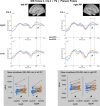Brain dynamics of the interplay between auditory selective attention and working memory during melody encoding
- PMID: 40594034
- PMCID: PMC12217724
- DOI: 10.1038/s41598-025-03378-w
Brain dynamics of the interplay between auditory selective attention and working memory during melody encoding
Abstract
Working memory and attention are jointly needed in most everyday life tasks and activities. They have however mostly been studied separately. Here we investigate how auditory working memory-in a delayed-matching-to-sample task-and selective attention interact using a recently introduced paradigm (MEMAT, for MEMory and ATtention) and MEG (Magneto-encephalographic) recordings in twenty-two participants. We manipulate the difficulty of the memory task and attentional filtering. When memory task difficulty increases, accuracy decreases, CNV (Contingent Negative Variation) amplitude in anticipation of the melody to encode increases, and the decrease in alpha power during encoding and maintenance in a left fronto-temporal network is reduced. When attentional filtering difficulty increases, accuracy decreases, the amplitude of the sustained evoked response during encoding increases, whereas the differential processing of relevant and irrelevant sounds in auditory areas is less pronounced, and frontal theta power during encoding and maintenance is higher. In the left auditory cortex, we directly observe the result of the interaction between auditory memory and attention: the facilitation of relevant sound processing in the easy filtering condition reduces when the memory task difficulty increases. This pattern mirrors the observed behavioural effects: a smaller difference in accuracy between attention conditions when the memory task difficulty increases. Overall brain dynamics highlight reciprocal influences of working memory and selective attention processes, in keeping with shared cognitive resources between them.
© 2025. The Author(s).
Conflict of interest statement
Declarations. Competing interest: The authors declare no competing interests.
Figures









References
-
- O’Leary, D. S. et al. Auditory and visual attention assessed with PET. Hum. Brain Mapp.5, 422–436 (1997). - PubMed
-
- Lipschutz, B., Kolinsky, R., Damhaut, P., Wikler, D. & Goldman, S. Attention-dependent changes of activation and connectivity in dichotic listening. Neuroimage17, 643–656 (2002). - PubMed
-
- Petkov, C. I. et al. Attentional modulation of human auditory cortex. Nat. Neurosci.7, 658–663 (2004). - PubMed
-
- Kawashima, R. et al. Selective visual and auditory attention toward utterances—A PET study. Neuroimage10, 209–215 (1999). - PubMed
MeSH terms
LinkOut - more resources
Full Text Sources

